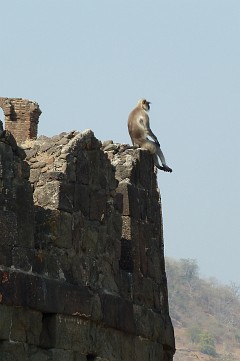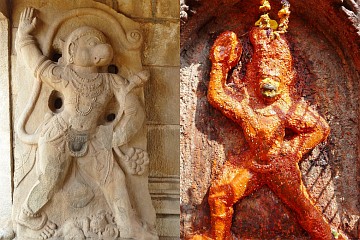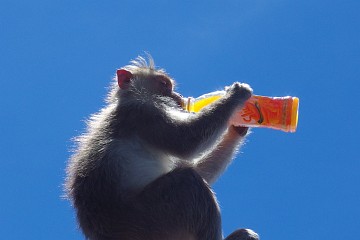Encounters with Monkeys
(vero;2016-July-03)
 Indians have a special love affair with monkeys which they believe are the living representation of Hanuman, the Monkey God. Hanuman is one of the key figures of the Ramayana, an epic relating the life of Rama (an avatar of Vishnu): as the demon Ravana, king of Lanka, kidnapped Sita, Rama's wife, it is Hanuman who came to the rescue with his monkey army. He crossed the strait of water between India and Lanka in one leap, found out where Sita was being held captive, led a furious war in Lanka, flew to the Himalayas in search of a remedy to restore the wounded of Rama's army and returned with a mountain full of medicinal herbs. And these are just a few of his achievements!
Indians have a special love affair with monkeys which they believe are the living representation of Hanuman, the Monkey God. Hanuman is one of the key figures of the Ramayana, an epic relating the life of Rama (an avatar of Vishnu): as the demon Ravana, king of Lanka, kidnapped Sita, Rama's wife, it is Hanuman who came to the rescue with his monkey army. He crossed the strait of water between India and Lanka in one leap, found out where Sita was being held captive, led a furious war in Lanka, flew to the Himalayas in search of a remedy to restore the wounded of Rama's army and returned with a mountain full of medicinal herbs. And these are just a few of his achievements!
For Hindus, Hanuman stands for courage, hope, knowledge, intellect and devotion. He has the tail and the head of a monkey and the body of a man. He is worshipped all over the sub continent, his cult associated to the one of Vishnu, in numerous shrines and temples. It is no wonder then, that monkeys are particularly cherished by Indian people who are always keen on feeding them when they can. Alas, this behaviour can be a double edged sword, as monkeys can be very cheeky and bold, and become a real pain/threat to humans as described in this newspaper article from 2012.
Monkeys in temples or ruins are a real nuisance. In temples, devotees come with offerings, often bananas, and it is not unusual to see monkeys attacking them to grab the fruit. Tourists make also a good target: they often have bottles, snacks in their hands and we have seen many monkeys snatching bags and bottles away, particularly going after children. It can get quite scary and we've seen many a tourist surrendering their bags and running away to escape them.
 We had plenty of opportunities to observe monkeys during our travels in India and Nepal. They are fascinating animals, but as a rule, we tend to be very careful when we see one …
We had plenty of opportunities to observe monkeys during our travels in India and Nepal. They are fascinating animals, but as a rule, we tend to be very careful when we see one …
One of our most moving encounter with monkeys was in Pushkar: we were walking through the city, exploring side lanes and residential neighbourhoods, when we came to a dirt track, bordered with trees. As we made our way, we noticed an agitated group of monkeys and suddenly saw a dead monkey lying on the ground: it had touched an electric line spanning the road and got electrocuted. The accident had just happened, although we did not see it. But what we observed was most touching: surrounding its corpse were many other monkeys, obviously completely confused as why it was not moving anymore and showing real signs of excitement and distress, as if they were mourning. It was fascinating to watch, but we followed the attitude of onlooking Indians and kept a respectful distance: they surely knew better and were on their guards, utterly cautious about the monkeys and their possible reaction.
This was 2013. This year, we had an encounter of a different type as we were having a rest in the Virupaksha temple in Hampi. We knew about the monkeys in the temple compound, so we refrained from eating anything, but thought nothing of having a drink of water. We sat in the shade on the steps of the temple office and just watched people passing by. All of sudden, a family waved frantically to us, but we were too late in understanding what they meant: a monkey was coming from behind us and was after the water bottle which was looking out of our day-pack. As we eventually realised what was going on, the monkey had already unscrewed the cap! Thomas, who was nearest to it, reacted instinctively and tried to scare it off. The monkey turned quite aggressive, hissed at him and went after his arm. It all happened so fast, we got really scared: all travel guides will warn you of getting bitten, scratched or even licked by animals, dogs, monkeys and bats in particular because of the danger of getting rabies, a fatal disease if not promptly treated (and of course, we had decided against the pre-vaccination programme). Fortunately, the scratch was only superficial: Thomas' tee-shirt was torn and he had a bruise, but no open wound, although a tiny little pearl of blood appeared on the bruise, which caused us a lot of worrying. We treated the spot immediately with iodine which we always carry with us to purify water and soon after with bleach. Unsurprisingly, we spent quite a lot of time googling for the symptoms of rabies afterwards!
Want to read more? Go back to Old Habits Die Hard or go on to Email Updates or go up to Blog
$ updated from: Blog.htxt Mon 28 Apr 2025 14:55:29 trvl2 — Copyright © 2025 Vero and Thomas Lauer unless otherwise stated | All rights reserved $




